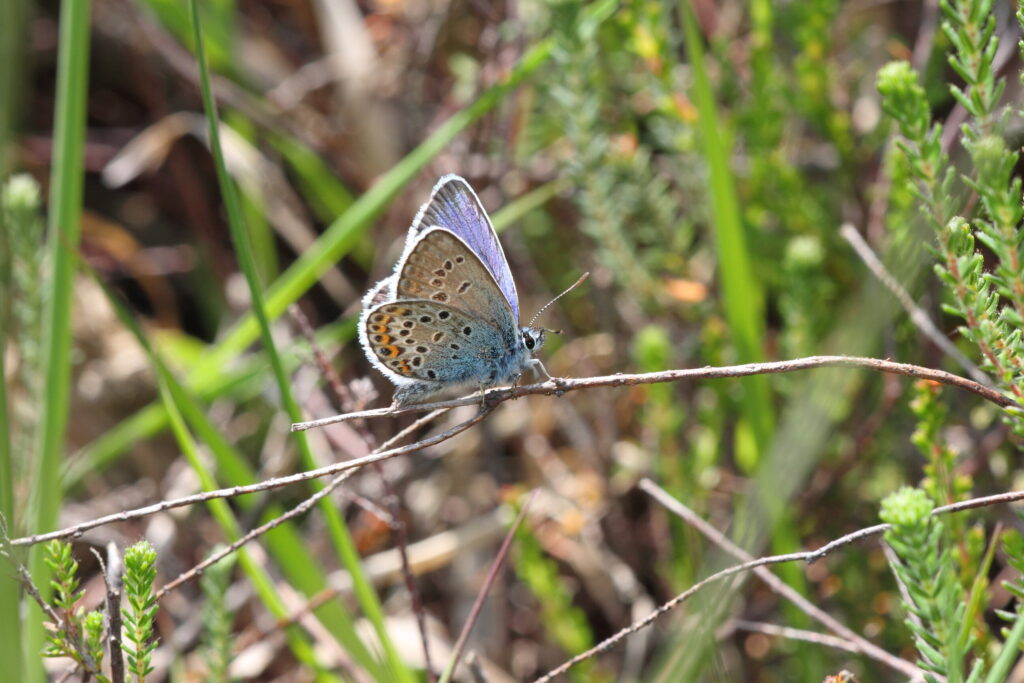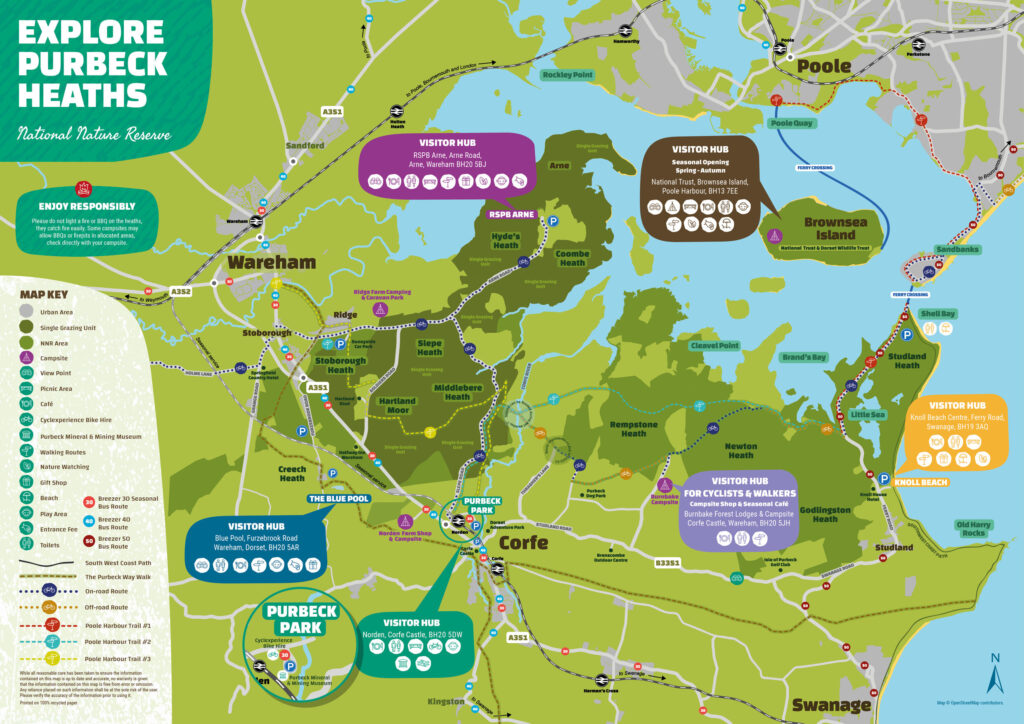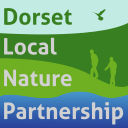By Robin Clarke, James Carter, Lydia Norrish, Isla Crawford, Flora Pilkington, Ella Hague
Heathland is one of Dorset’s most iconic and important landscapes. Characterised by swathes of purple heather and clusters of yellow gorse, this is more than just a picturesque environment. Heathland is one of our richest and most diverse ecosystems, a home for many species, some very rare, others more common, but all playing a vital role in supporting each other in the heathland’s complex web of life. As you’ll find out, humans initially created this unique environment, but unfortunately we’re now abusing our responsibility; fragmenting and destroying this incredible wildlife habitat in an astonishing number of ways. However, as you read on, you’ll also learn how some great organisations and projects are making a real difference, and how there are small things you can do to ensure both people and nature can enjoy the heaths for years to come.

Around 5,000 years ago, heathlands first started to form, in fact not naturally, but by the action of humans. This process included deforestation to clear land for farming, and subsequently grazing livestock. Much of the vegetation was removed, leaving a minimal source of nutrients for the soil, which became more acidic. Only more hardy plant species could colonise and survive; this included shrubs such as heather, gorse and bracken, and the occasional tree, including birch, rowan and willow.
Upton Heath © Tonty Bates
In fact, if heathlands were left undisturbed, more trees would have the opportunity to grow, and in turn enrich the soil with leaf litter, eventually forming woodland. However, continued human intervention, such as grazing, has largely prevented this from happening, preserving a unique habitat for both wildlife and people to enjoy.
Dorset now has approximately 8,500ha of heathland, much of which is lowland heath: found below 300m on free-draining sand and gravel soils. While large extents remain in the rural Isle of Purbeck, the rest has been fragmented by development and agriculture, leaving smaller pockets in urban Poole and Bournemouth. There is also dune heath, found by the coast, where heather colonises sand dunes during the process of succession, the best example in Dorset being at Studland.
Heathland is such a unique environment that it is home to many specialist species that can’t survive anywhere else. The heather itself is very important for heathland animals as it’s the foodplant for the caterpillars of 55 moth and butterfly species, ranging from the UK’s smallest butterfly, the silver-studded blue, to our largest moth, the emperor hawk moth. These are just a tiny proportion of the 5,000 total invertebrate species found on Dorset’s heathlands.
Silver Studded Blue © Steve Davis

These areas also have valuable microhabitats, such as ponds, which are inhabited by raft spiders. These incredible arachnids can eat not only insects, but amazingly tadpoles and small fish! This rich diversity of invertebrates supports species further up the food chain, such as Dartford warblers and woodlarks. When night falls on the heath, moths are hunted by nightjars, which use their whiskered faces and wide mouths to catch them. Meanwhile on summer days, hobbies hawk for dragonflies mid-flight. Many of these bird species rely on heathland to breed, using the dense heather and gorse to hide their nests in, safely obscured from predators. This rich food supply, coupled with the warm climate for basking in the sun, also allows all 6 of the UK’s native reptiles to make their home on the heaths. Dorset’s heathlands are a particular stronghold for one of our rarest reptiles, the sand lizard.
Unfortunately, this extraordinary biodiversity is under the pressure of a perfect storm of threats. One third of Dorset’s heathlands are in the urban areas in the south-east of the county, and they were seriously threatened by issues such as building development, primarily taking place in the 1970s and 80s. This is what led to fragmentation, which isolated the habitats and wildlife living there and made them more vulnerable to other, growing pressures. Fortunately, much of our heathlands are now designated as protected areas and afforded safety from development, although this doesn’t resolve all threats to heathlands. Our urban heaths in particular are prone to heavier visitor pressure. Whilst visiting these areas can inspire people to love and protect them, unsustainable levels of erosion and trampling can be damaging. Dogs which are walked off-lead can disturb ground-nesting birds, while their faeces add nutrients to the naturally infertile soil, adversely affecting heathland plants adapted to a nutrient-poor environment. Another unwanted source of nutrients is air pollution, especially nitrogen and ammonia, while also heavily affecting moss and lichen species. As if this wasn’t enough, the dry nature of heathlands makes them susceptible to perhaps the greatest threat of all: fire. Wildfires have severely threatened Dorset’s heathlands, for example, a fire in Wareham Forest in 2020 burnt over 200ha of habitat over two weeks. Sadly, arson can cause many of these fires, although discarded barbecues and cigarettes are also major culprits.

Fortunately, there are solutions to protect heathlands from many of these threats. In Dorset, the Isle of Purbeck’s valuable lowland heaths were recently given a boost thanks to the declaration of the Purbeck Heaths National Nature Reserve. This ‘super-NNR’ combined three existing NNRs (Hartland Moor, Stoborough Heath and Studland and Godlingston Heath) with new land, in total covering 3,331ha.This makes it the largest single nature reserve of lowland heath in England! As we’ve already seen, this designation should offer protection from threats such as development, as well as increasing its resilience to larger-scale issues such as climate change.
Furthermore, the reserve should encourage greater tourism and visitor engagement, crucially in a responsible way. This has included the creation of a Sustainable Tourism Plan and digital information hub (we recommend you check this out to plan a visit!), paired with better signage and interpretation boards on the ground. While NNRs themselves are declared by Natural England, the Purbeck Heaths brings together multiple partners and landowners, including Amphibian and Reptile Conservation, the Dorset Wildlife Trust, Forestry England, the National Trust, the Rempstone Estate and the RSPB, all collaborating to ensure the reserve delivers for its wildlife.
Alongside the Dorset AONB, and funding from the Green Recovery Challenge Fund and Wytch Farm Landscape and Access Enhancement Fund, some of these organisations are also working on one of the most exciting projects within the NNR: the Purbeck Heaths Grazing Unit. This has involved expanding a more natural grazing system across 1,370ha of heathland, with a view to creating a ‘mini New Forest’. Cattle, ponies and pigs will be able to roam freely across the landscape, grazing and trampling the vegetation. While this may seem destructive, this disturbance is in fact vital for creating microhabitats, or niches, for rare and threatened species. Sand lizards, Purbeck mason wasps, and heath tiger beetles all specialise in exploiting bare sand, which has become overgrown in the absence of large herbivores. GPS collars to track cattle, drones to map habitats, and trail cameras to monitor species, will all be used to survey the long-term improvements for the heathland ecosystem, by comparing findings to baseline data. So far though, the project has removed 7km of internal fencing to improve connectivity within the site, and constructed a 19.9km pig-proof perimeter fence to prevent escapees!
This landscape-scale restoration is vital, but difficult on our smaller, fragmented areas of urban heathland. This is where the work of the Urban Heaths Partnership comes in, a team employed by the Dorset and BCP councils. Their heathland mitigation falls under three main areas. Firstly, they help provide SANGs (Suitable Alternative Natural Greenspaces), which are outdoor areas for recreation and leisure where people can, for example, walk their dogs off-lead, instead of doing so on heathlands. This consequently relieves visitor pressures on our more sensitive heath environments. Secondly, they raise awareness of the threats we pose to our heaths through school visits and public engagement projects such as Dorset Dogs and Firewise, which educate the public on how to protect heaths. And finally, they carry out monitoring to assess how our heathlands are faring and the impact of their work on both wildlife populations and visitor numbers.
Despite the fragility of heathlands, the Urban Heaths Partnership shows that it is possible to visit them responsibly and sustainably. If you want to experience these habitats for yourself (which we recommend you do), make sure to keep yourself, and any four-legged friends, on the footpaths to minimise disturbance to wildlife. Also, make sure not to have fires, such as barbecues, which can easily get out of control. And finally, if you want to make even more of a difference, you can also get actively involved in volunteering to help conserve and restore Dorset’s heathlands, by checking out the websites of the Dorset Wildlife Trust, Amphibian and Reptile Conservation, and Dorset Dogs. Whether you volunteer with a work party, or simply take care when visiting heathlands for yourself, you can be safe in the knowledge you are safeguarding these amazing wildlife habitats for future generations.
